#lluís borrassà
Text
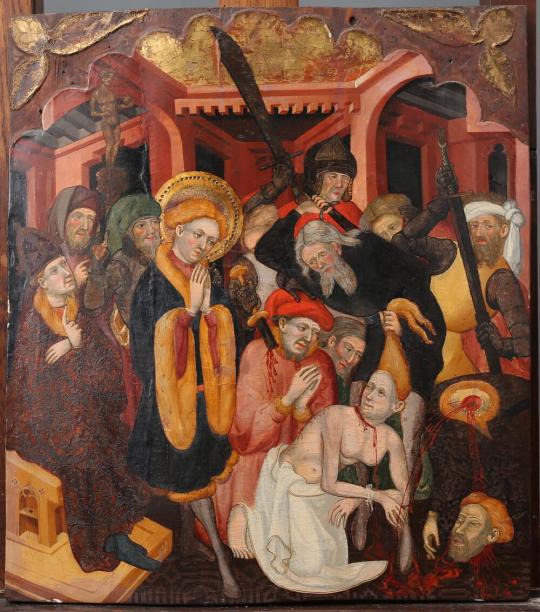
Lluís Borrassà
Martyrdom of the servants of St. Hippolytus
Tempered paint and gold leaf on panel, 69 x 61cm, 1419-20
22 notes
·
View notes
Text
Lamento sobre Cristo muerto (detalle)
Obra de Lluis Borrassà (1411) insertada enel Retablo del Espíritu Santo de Pere Serra.
The central piece with the Lament over the Dead Christ was painted by Lluís Borrassà in 1411 for an altarpiece dedicated to Saint Anthony the Abbot, a work commissioned on 24 January 1408 from the carpenter Pere de Puig regarding the structure and of which only this piece is preserved. The style of this artist…
View On WordPress
#Cataluña#Colegiata Basílica de Santa María (Manresa)#España#Gótico#Gótico Internacional#Lluis Borrassà#Pere de Puig#Pere Serra#Siglo XV
0 notes
Text
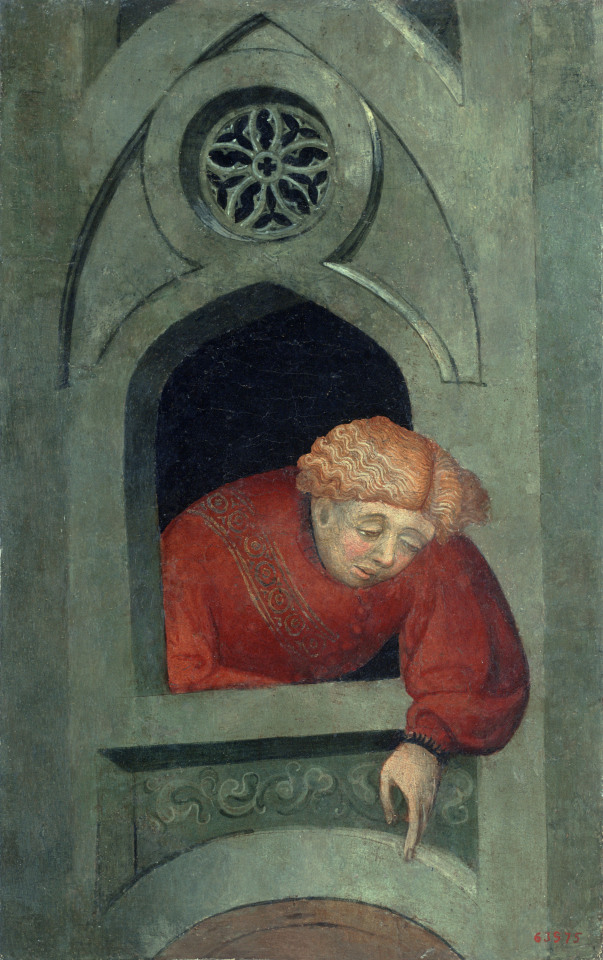
~ Young Man Leaning out of the Window.
Date: 1400-1415
Artists/Makers: Lluís Borrassà Girona (ca. 1360 –Barcelona, 1424/1425)
#15th century#15th century art#young man leaning out of the window#window#young man#lliuís borrasà girona#1400#1410#medieval#middle ages#art history#history of art#history#archeology#museum
121 notes
·
View notes
Text
关于拷问 涩泽龙彦
一、痛苦和快乐的相似
用简单明快地话来说,拷问是由人类发明,只属于人类领域的事物。而动物们无论做出多么残酷野蛮的行为,它们都有着生物学上的必然理由。而拷问,比如推翻宗教信仰、思想上的信念,同样身为人类折磨另一个人类,这在动物的世界中是绝不会��生的。这么看来,明显属于人类领域的拷问,果然和动物中绝无可能存在的色情概念相类似,是属于心理学方面的一种探求。
“猥亵行为是对羞耻心冒渎的逆转,拷问是对怜悯冒渎的逆转。”Thierry Meunier写过这样的话。确实,拷问和猥亵行为相似,是非持续性的人类追求持续的一种手段,一种基本上可以视作是绝望的交流手段。
色情行为,男人把女人脱光,伴随着女人的羞耻心一起,使她成为一种非持续性的存在,必然这也会剥下绝对领域的薄膜。夺走了羞耻心,夺走了衣服,她宛若被卸除了武装一般,与存在的普遍持续性相对,成为了完全开放的状态。猥亵则是有着扰乱该个体的非持续秩序、打破日常社会生活的形态、一种不安定的开放状态的含义。也就是说衣服被脱掉这件事,可以看成是使我们存在的非持续形态解体的色情行为的第一步,性高潮是这种解体的最终完成阶段。
和这种色情的过程完全符合,在拷问台上的人类,首先被夺走的是人对人应抱有的怜悯之情。他不能请求拷问的执行者对他可怜。为死的持续性开辟道路,这种不安定的开放状态,和作为色情行为的猥亵状态、赤裸状态极为相似。但两者在试图恢复两个个体的被断绝的交流上,一个是使人快乐,一个是使人痛苦,这点不同。拷问的最终完成阶段,拷问的高潮是死。因此,不管在哪儿,非持续的个体都在持续中得到了解放。
基督教的伪善在于,给予肉体痛苦,对我们肉体的关注,能从肉体回归到精神上这点。为了避免犯错的肉体,给予其最大限度的痛苦——这是来自中世纪僧侣所考虑的所谓禁欲精神、苦修的目的。他们认为,为了让意识脱离肉体,最好尽可能地肆意对肉体残酷虐待;让精神完全独立于肉体,精神处于支配者的地位,再没有比苦修更合适有效的手段了。但这种想法错了。精神终究无法从肉体上完全独立,经常成为肉体的共犯者,遭遇失败。也就是说,会无法区分痛苦和快乐,对精神的肉体的关注,无论如何都只是停留在对肉体的关注上。
异端审判官的拷问,警察对思想犯的拷问,是更为阴险、伪善的快乐。
异端审判官的隐秘的快乐,不一定只在欣赏对方承受肉体上的痛苦。伴随着肉体上的痛苦,对方的精神产生动摇,超越了能承受的极限,终于屈服为了肉体的共犯者,观赏背叛精神的这整个过程是十分快乐的。这宛若和向缺乏恋爱经验的天真纯洁的姑娘,授受爱的技术和快乐的猎艳家的引诱乐趣一样。纯洁的处女被猎艳家所引诱,无意中输给了肉体的快乐,她的精神屈服为了肉体的共犯者,正如���想犯因为拷问带来的痛苦而转变的过程。如波德莱尔所言,肉欲行为确实和拷问相类似。痛苦和快乐,在对人的精神和肉体的作用上,显示出了相似的形式。
二、拷问动机的分类
据Roland Villeneuve的《拷问博物馆》(巴黎,1968年)①一书所言,人类进行肉刑、拷问的动机有以下繁多的种类:
(1)战争后遗症——赢得战争的部落,为了让输掉的部落不会再度拿起武器,或者说为了让他们不再有生殖能力,会切除相应的身体器官,将他们变成奴隶。
(2)复仇——美国的印第安人经常将敌人的头皮连着头发一起剥下来,作为战争的纪念品。另外原始民族进行的猎首、纪念打胜仗的庆宴上吃人肉等也属于该类。
(3)宗教——古代东方的牺牲宗教(巴力、摩洛等),为了向使宇宙正常运行的神祈愿,会将孩子、女人作为活祭品献给神。在印度,祈愿农作物的丰收,会向时母神献上活祭品。
(4)魔法——为了制造某些种类的软膏、冲剂和蜡烛,会割下孕妇的肚子、摘除健康男性的器官。据说十七世纪法国的魔法师Guibourg进行的黑弥撒,曾杀死婴儿,将他们的血收集在圣杯里过。
(5)刑罚欲望——为了强调刑罚的可怕,中世纪的欧洲、中国,使用过非常残忍的拷问手段。
(6)现实利益的动机——盗贼、强盗为了钱抢夺财,会用东西堵住人的嘴,以烧伤、刀伤的方式弄伤人给予威胁。诱拐儿童、女性也包含在该类。
(7)强制自白—— 过去,审判预审时,审判员做这样的事很普遍。西班牙的异端审判、军国主义日本的特高警察、纳粹的盖世太保、苏维埃的格别乌、阿尔及利亚的法国军队等等。
(8)所谓的科学研究——战争中,日本九州大学的医学部,对美国飞行员俘虏所进行的活体解剖实验,我们现在还记忆犹新。
(9)色情——一般根据剥下牺牲者的衣物、使身体器官暴露、流血,拷问多多少少能使拷问执行者的施虐癖得到满足。看上去像纯粹实用手段的拷问(比如说鞭打),很多时候都含有着色情动机。
三、对于出现在美术中的拷问的考察
世间有很多拷问爱好者,这和有很多色情爱好者的理由一样,用不着区别看待。他们对以前拷问器具和处刑用具的极度讲究,对此而产生的对沾满血迹的血的怜惜,对不再进行拷问的现代的人道主义风潮这些感到感叹不已。他们只能借着想象力去追忆亚述巴尼拔王②和托尔克马达③的伟业。话虽如此,萨德、米尔博④和巴塔耶留下了许多贵重著作,这刺激了他们的想象力,以宗教艺术为借口,制作了很多巧妙地隐藏着虐待狂本能的绘画、雕塑作品。这让他们充分感受到了赏心悦目。
米开朗基罗的索多玛刑罚图、Orcagna和Taddeo di Bartolo的地狱图、Niklaus Manuel Deutsch的《一万基督教徒的殉教图》等等,都能说是借宗教艺术之名的血浆趣味的虐待狂绘画吧。很多画家画的《基督笞刑图》同样也是包含着很有味道的奇妙暗示和象征的作品。
比如说,请看看中世纪时期西班牙加泰罗尼亚画家Lluís Borrassà的《基督笞刑图》(卡斯特尔美术馆)吧。
两位拷问执行官所握的笞仗明显暗示的不就是勃起的男根吗?再看看他们享受的表情和姿势,画家在这里暗示的是自慰场景基本上确凿无疑了吧。更仔细地看,在这根笞杖男根上,三条捻线甚至像喷泉似的飞了起来。这些全是来自画家的恶作剧吗?还是说是委托绘画的贵族的要求呢?无论如何,这副完全是在冒渎基督的大胆妄为的构图,以让自慰者愉悦为目标的画家的挑动意图,可说是显而易见吧。
再让我们看看现在瑞士的巴塞尔美术馆所藏的一幅文艺复兴时期德国代表画家Hans Holbein的《基督笞刑图》吧。
这不就是性倒错者的骄傲游行吗?看着像胆怯含羞的年轻姑娘似的、奇妙地两脚并在一块儿的基督,带着Androgynos(两性具有者)的圆润身材,正在向拷问执行者求可怜。围住基督的拷问执行者们里面,右侧使劲儿用力挥着笞的男子,股间紧绷着小帐篷顶着,表情凶狠,这人是个虐待狂吧?左侧则有个宛若笞是鞭打在自个儿身上, 幻想着基督的痛苦呈现在他身上的激动异常的受虐狂男子。 而从最右侧的房间外面,还能看到有个在偷看的不举者的老人的身影。
①《Le musée des supplices》。
②亚述巴尼拔:公元前六百年时的亚述国王,当时亚述实行军国主义。
③托尔克马达,西班牙天主教多明我会僧侣,西班牙异端裁判所首任大法官,1480至1530年间处死了数千名异教徒。
④米尔博(Octave Mirbeau): 中文书籍有《一个神经衰弱者的二十一天》(作家出版社,1996)和《秘密花园》(重庆出版社,2005)。
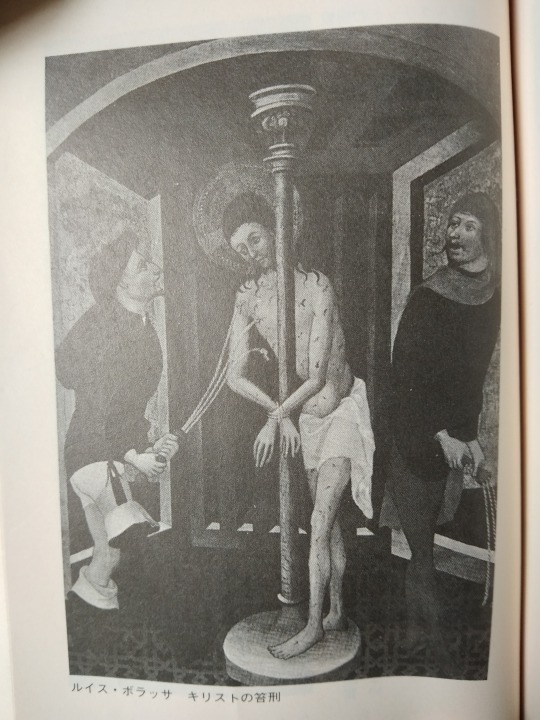
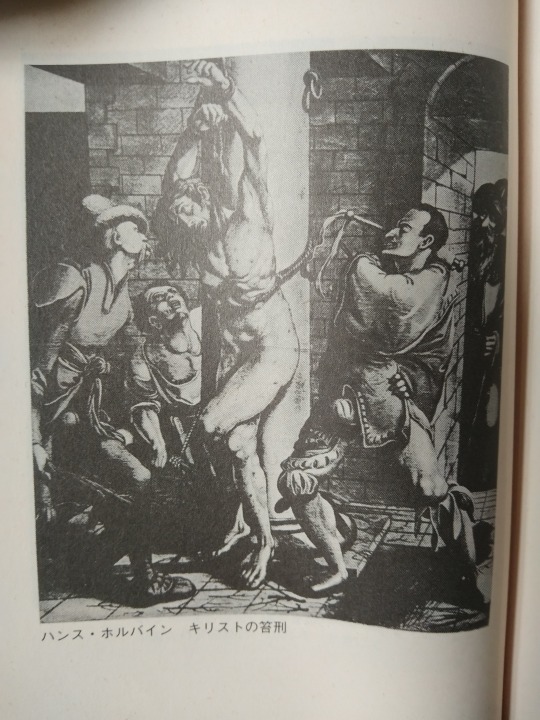
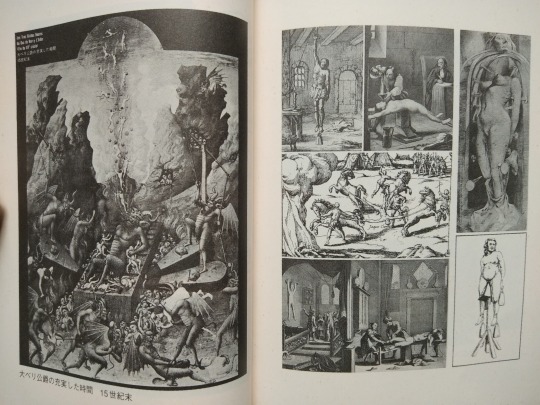


色情和残酷的综合研究志 《 血和蔷薇 1 》
0 notes
Photo

-(Historia del Arte) Salvat Editores- Basada en la obra escrita por José Pijoan. Página 95. Biblioteca personal. (1411) Lluís Borrassà.
En esta ilustración del medioevo se ve la relevancia del uso del color rojo, en este caso el color denota primero la jerarquía de quienes lo llevan en sus prendas de vestir (personajes religiosos) y segundo su uso en el ambiente le da un aire oscuro y tenebroso, la ilustración misma es un relato de sacrificio, muerte, demonios y pecado.
0 notes
Photo
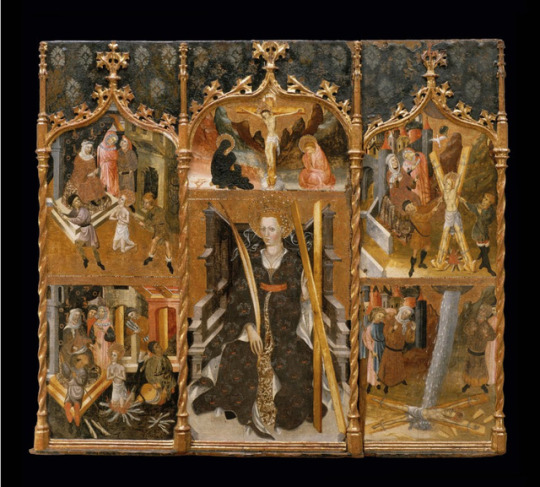
The episcopal museum of Vich was inaugurated in the year 1891 by the bishop Josep Morgades, who at the time presided the Archaeological Society of Vich. This society had created the Lapidary Museum on the occasion of the discovery of the Roman Temple of Vich in the year 1882, base of the Episcopal Museum.
His first installations occupied the space located on the cloister of the cathedral of Vich and the palace of the bishop. In 1898 he was appointed conservator of the Josep Gudiol i Conill Museum, thanks to which the collections increased considerably. This work was continued with great effort, between 1931 and 1978, by Eduard Junyent. With the great increase of the collections in 1941 they moved to the old school of Sant Josep, located next to the cathedral. In 1995, under the architectural direction of Alfons Milà and Frederic Correa, the school of Sant Josep was rebuilt, building a new building to house the large collections it has available.1 In 2001, the Generalitat de Catalunya declared it a museum of national interest .
The Episcopal Museum of Vic conserves a magnificent collection of medieval art with paintings and sculpture from the Catalan Romanesque and Gothic periods. The collections of precious metals, textile, foundry, glass and ceramics offer a complete journey through the history of liturgical and decorative art in Catalonia.
All of the collections housed in the Museum’s permanent exhibition are ordered chronologically and stylistically.
The archaeological collection covers a wide time span, ranging from pre-history to late antiquity and the high medieval period. Next to it we find the lapidary, which contains works in stone
ranging from the Romanesque to Baroque periods.
The Romanesque and Gothic rooms contain the museums most valuable works, which have brought it worldwide renown. Of particular note from the Romanesque period is the Descent from the Cross from Erill la Vall and the canopy from the Valley of Ribes, as well as an important group of altar frontals.
Outstanding works from the Gothic collection include the Virgin of Boixadors, the altarpiece depicting the Passion by Bernat Saulet and works by the greatest Catalan artists of this period, such as Pere Serra, Lluís Borrassà, Bernat Martorell and Jaume Huguet. The creation of an outstanding area which recalls the architectural forms of our Gothic patios allows perfect viewing of the magnificent Gothic altarpieces of Santa Clara and Guimerà, the works of Lluís Borrassà and
Ramon de Mur respectively.
var quads_screen_width = document.body.clientWidth; if ( quads_screen_width >= 1140 ) { /* desktop monitors */ document.write('<ins class="adsbygoogle" style="display:inline-block;width:468px;height:60px;" data-ad-client="pub-9117077712236756" data-ad-slot="9839843423" >'); (adsbygoogle = window.adsbygoogle || []).push({}); }if ( quads_screen_width >= 1024 && quads_screen_width < 1140 ) { /* tablet landscape */ document.write('<ins class="adsbygoogle" style="display:inline-block;width:468px;height:60px;" data-ad-client="pub-9117077712236756" data-ad-slot="9839843423" >'); (adsbygoogle = window.adsbygoogle || []).push({}); }if ( quads_screen_width >= 768 && quads_screen_width < 1024 ) { /* tablet portrait */ document.write('<ins class="adsbygoogle" style="display:inline-block;width:468px;height:60px;" data-ad-client="pub-9117077712236756" data-ad-slot="9839843423" >'); (adsbygoogle = window.adsbygoogle || []).push({}); }if ( quads_screen_width < 768 ) { /* phone */ document.write('<ins class="adsbygoogle" style="display:inline-block;width:468px;height:60px;" data-ad-client="pub-9117077712236756" data-ad-slot="9839843423" >'); (adsbygoogle = window.adsbygoogle || []).push({}); }
The liturgical materials and clothing collection illustrates their evolution from the III to the XX century. Here we can find the pallium of the Witches, as well as other works of unquestionable historical and artistic value.
The glassware, leatherwork, precious metals and ceramics take us on a journey through the history of liturgical and decorative art in Catalonia.
On completing the tour of the permanent exhibition you can continue your visit around the study galleries. These visitable storerooms follow the same criteria of chronological and stylistic ordering for all collections.
OPENING TIMES
Tuesday to Friday, 10 a.m. to 7 p.m. (April to September)Tuesday to Friday, 10 a.m. to 1 p.m. and 3 p.m. to 6 p.m. (October to March)Saturday, 10 a.m. to 7 p.m.Sunday and holidays, 10 a.m. to 2 p.m.
Study Galleries
Morning from 12 p.m. to 13 p.m.
Afternoon from 17 p.m. to 18 p.m.
The Museum is closed on Mondays; 1st and 6th January; Easter Sunday; and 25th and 26th December
VISITS
Guided visits
Every Saturday and Sunday at 12 noon, free guided visit to the Romanesque and Gothic Art collections. Free service for the Museum visitors.
Multimedia guide
Adapted for Apple and android systems, offers a tour through Romanesque great collection of the MEV.
Family visits
Discover the mediaeval world. Participative visit with the family to the Romanesque and Gothic collections. Every Sunday at 11 a.m. 5 years minimum. Free service for the Museum visitors.
Group visits
Guided visits for groups from Tuesday to Sunday. Available in different languages. The Museum purposes visits for groups to all its collections or a mediaeval tour of the Romanesque and Gothic painting and sculpture rooms. We offer a one hour and 30 minutes or a two-hour visit according to the group’s interests. Group visits must be booked in advance, whether they are guided or not. For further information and bookings call 938 869 360 or send an email
FACILITIES
Rest area
On the second floor, with views to the Romanesque bell tower of the Cathedral and the historical center of Vic town.
Observation sheets
At the entrance of the Museum you can ask for free materials to make a family museum visit.
Accessibility
The Museu Episcopal de Vic guarantees that all persons have access to the exhibition rooms, the Museum’s services and activities. The Museum has elevators, ramps and bathrooms that are adapted for visitors with mobility impairments. Free wheel-chair service.
Cloakroom
The Museum has a free cloakroom at the entrance. For security reasons you must deposit bags, backpacks, umbrellas or objects larger than 40x40cm in the cloakrooms. The Museum shall not be held responsible for any article left in the cloakroom.
Museu Episcopal de Vic, Spain was originally published on HiSoUR Art Collection
0 notes
Video
youtube
Places to see in ( Tarragona - Spain ) Catedral Basilica Metropolitana Primada de Tarragona The Cathedral of Tarragona is a Roman Catholic church in Tarragona, Catalonia, Spain. Located in a site previously occupied by a Roman temple dating to the time of Tiberius, a Visigothic cathedral and a Moorish mosque, it was declared a national monument in 1905. Tarragona Cathedral is in transitional style from the Romanesque to the Gothic one. It has a basilica plan with a nave and two aisles, a transept with unequal arms, three semicircular apses with deep presbyteries. The apse has three windows in the lower part, and other seven in the upper one, of ogival shape. The unfinished main façade of Tarragona Cathedral has three portals, corresponding to the nave and the aisles; the central one is in a Gothic style with similarities to that in the Cathedrals of Amiens and Reims, with ogival arcades, while the other two are in Romanesque style. The main gate is surmounted by a large rose window, similar to that in the Monastery of Sant Cugat or in the Cathedral of Majorca. The twelve spokes represent the twelve tribes of Israel, or the apostles. It has a diameter of 11 meters. The two lateral portal have also smaller rose windows. Tarragona Cathedral includes the following chapels, starting from to the right of the entrance towards the choir: Chapel of the Virgin Mary (1520). The altarpiece, coming from the parish church of Solivella, was executed by Mateu Ortoneda in the early 15th century. Chapel of the Virgin of Montserrat, with an altarpiece from the church of Santes Creus, begun by Guerau Gener and finished by Lluís Borrassà in the early 15th century. Chapel of the Conception. in Baroque style (1674), with works by sculptor Francesc Grau and painter Francesc Tramulles Roig. Chapel of St. Fructuous and St. John, designed in Renaissance style by Pere Blai Chapel of the Holy Sepulchre (1494), housing a 4th-century AD Roman sarcophagus with Gothic additions (Gothic made by an anonymous Valencian sculptor) Chapel of the Holiest (1592), in the right transept. It features a large triumphal arch as entrance, an octagonal dome, three chapels with semicircular arches and works from Jaume Amigó, Pere Blai and Bernat Cáceres Chapel of St. Barbara (14th century) Chapel of St. Mary de los Sastres, built before 1350 and later renovated. It has a hexagonal plan and an altarpiece (1368) by Aloi de Montbrai. Major Chapel, featuring a notable Gothic sculpture by Pere Johan (1426–1434) in polychrome alabaster Chapel of St. Oleguer Chapel of St. Luke Chapel of St. Thomas (16th century) Chapel of the Christ the Healer (15/16th century) Chapel of the Rosary (16th century) Chapel of the Presentation Chapel of St. Francis (1584), designed by Jaume Amigó Chapel of St. Tecla, built in 1777 in late Baroque style over what was once the baptistery Chapel of St. Michael and All the Angels (mid-14th century). It contains a sculpture decoration with angels attributed to Jaume Cascalls and an altarpiece, depicting St. Michael, by Bernat Martorell (15th century) from the church of Pobla de Ciérvoles. Chapel of the Baptistery (1340–1344), with numerous sculptures featuring the Evangelists with their symbols, and other human and saint figures ( Tarragona - Spain ) is well know as a tourist destination because of the variety of places you can enjoy while you are visiting the city of Tarragona . Through a series of videos we will try to show you recommended places to visit in Tarragona - Spain Join us for more : https://www.youtube.com/channel/UCLP2J3yzHO9rZDyzie5Y5Og http://ift.tt/2drFR54 http://ift.tt/2cZihu3 http://ift.tt/2drG48C https://twitter.com/Placestoseein1 http://ift.tt/2cZizAU http://ift.tt/2duaBPE
0 notes
Photo
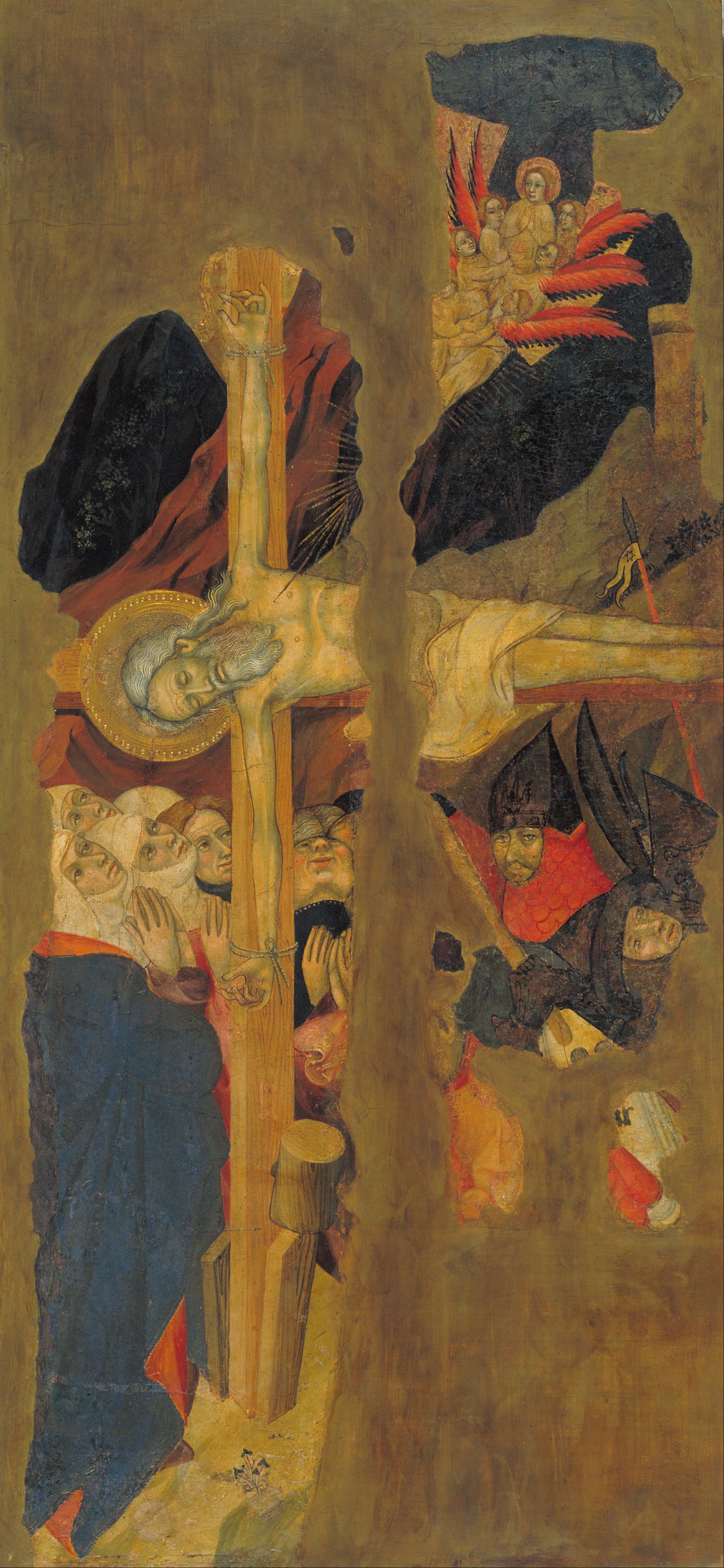
Lluís Borrassà
The Crucifixion of Saint Andrew
c. 1400-1415
109 notes
·
View notes